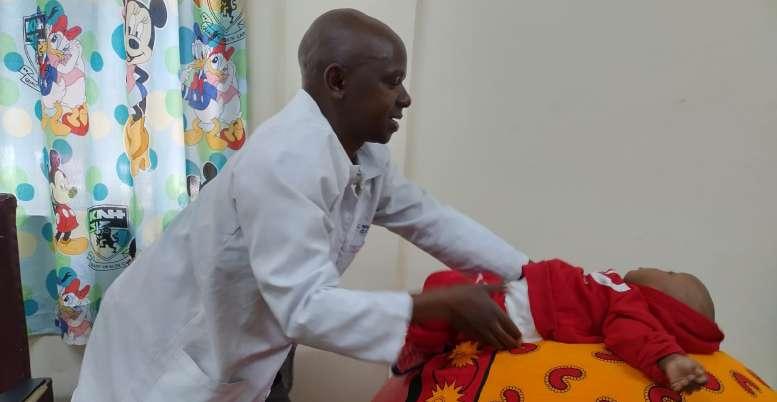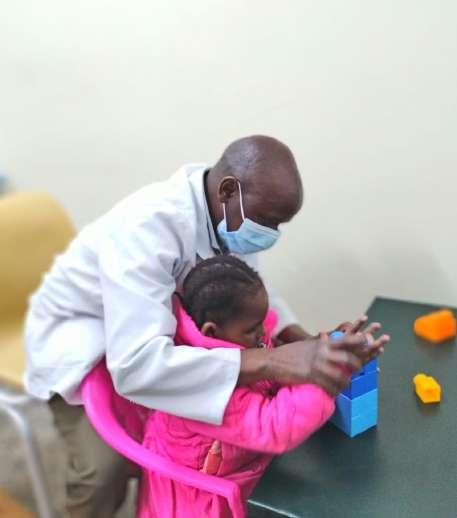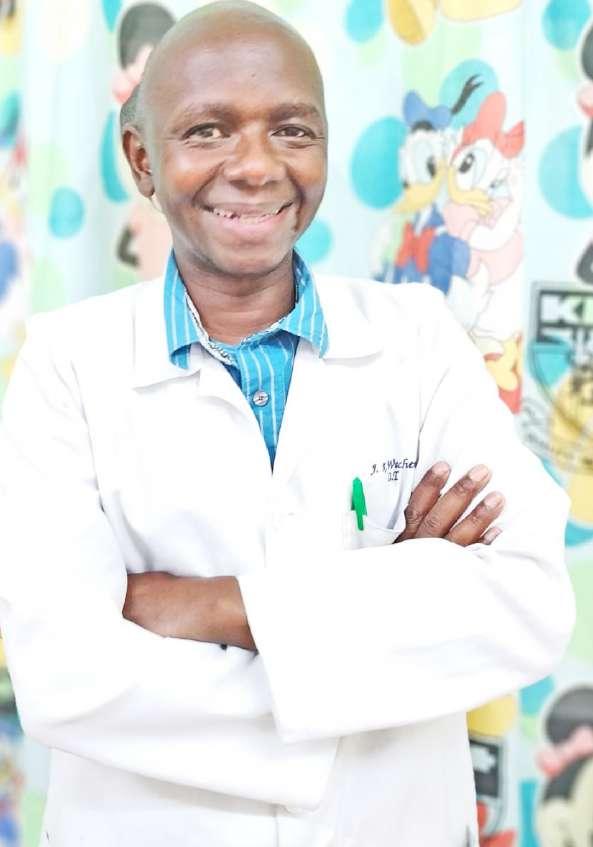
7 minute read
Understanding the Crucial Role of Occupational Therapy at Mama Margaret Uhuru Hospital(MMUH)
By Effie Mboya
Occupational Therapy (OT) is an essential part of healthcare that helps patients achieve their goals and improve their ability to perform daily living activities.
Advertisement
In an interview with Newsline, Mr. Jackson Wachenje, a Pediatric Occupational Therapist at Mama Margaret Uhuru Hospital (MMUH), shared insights on what a typical day looks like and the common conditions and challenges they help patients with. He also discussed the importance of involving family members or caregivers in a patient’s treatment and collaborating with other healthcare professionals to treatment plans based on their specific conditions and goals. Conducting therapy sessions with individual patients or groups of patients to help them improve their ability to perform daily living activities, such as bathing, dressing, and eating. Using specialized equipment and tools to help patients improve their fine motor skills, strength, and coordination. Collaborating with other healthcare professionals, such as doctors and physical therapists, to ensure comprehensive care for patients. Documenting patient progress and communicating with other members of the healthcare team to ensure continuity of care. Educating patients and their families or caregivers about their conditions, treatment plans, and home exercise programs. Keeping up-to-date with the latest research and developments in the field of occupational therapy through continuous education and professional development opportunities.
What are some common conditions or challenges that you handle at MMUH?
• Mental health conditions: Mental health conditions, such as anxiety or depression, can also impact a person’s ability to carry out daily living activities.
• Developmental disabilities: Children and adults with developmental disabilities, such as Down syndrome or autism, may require assistance with activities of daily living, such as bathing, dressing, and feeding.
In addition to these conditions, occupational therapists may also work with patients who have experienced trauma or who are recovering from surgery or illness. Ultimately, the goal of occupational therapy is to help patients achieve their goals and improve their ability to participate in daily living activities, regardless of their condition or challenges.
Furthermore, as occupational therapist, we have different areas where we do our interventions. We have occupational therapy, training, and developmental milestones. For those children who have not achieved the milestones like head control, sitting, crawling, standing, and walking. Basically, what you have seen here, I would say, is facilitating those milestones through different methods.
If a child has low muscle tone, we do have activities that enhance stimulating those muscles to be able to perform. For example, you can position the child in a prone position. By so doing, the child is able to lie down and is able to raise their head. If you place a toy up, the child is able to look at it. You are going to achieve eye-hand coordination. The child will be able to reach if the child has not yet achieved that reach, grasp, and release. And by so doing, you are able to gain head control.
We do have sensory integration interventions for children with sensory processing disorders, which include autism, attention deficit hyperactivity disorder(ADHD), and learning disabilities like dyslexia. So for such cases, we normally do a sensory integration process in which we are able to reorganize the way the brain performs those functions.
How do you involve family members or caregivers in your patients’ treatment?
Involving family members or caregivers in a patient’s treatment is an important aspect of occupational therapy. This helps to ensure that patients receive consistent support and assistance with their daily activities, even outside of therapy sessions.
Education: We educate family members or caregivers on the patient’s condition, treatment plan, and home exercise program so that they can provide support and reinforcement at home.
Training: We train family members or caregivers on techniques or strategies that can be used to assist the patient with daily activities or exercises.
• Observation: We may observe family members or caregivers as they assist the patient with daily activities to provide feedback and guidance on how to improve the patient’s performance.
• Communication: We communicate regularly with family members or caregivers to update them on the patient’s progress, discuss any concerns or issues, and make adjustments to the treatment plan as needed.
• Collaboration: We work collaboratively with family members or caregivers and other members of the healthcare team to ensure that the patient is receiving comprehensive care that addresses their physical, psychological, and social needs. By involving family members or caregivers in a patient’s treatment, we create a supportive environment that maximizes the patient’s potential for success and improves their quality of life.

Mr. Jackson with 10 month old patient with Down Syndrome
PHOTO |EFFIE SANDE
How do you collaborate with other healthcare professionals, such as doctors and physical therapists, to ensure comprehensive care for your patients?
Collaboration with other healthcare professionals is an essential part of occupational therapy. By working together, we can provide our patients with comprehensive care that addresses their physical, psychological, and social needs. Here are some ways that I collaborate with other healthcare professionals:
• Communication: I communicate regularly with doctors, physical therapists, and other members of the healthcare team to share information about the patient’s condition, treatment plan, and progress. This can help to ensure that everyone is on the same page and that the patient is receiving consistent care.
• Referrals: I may refer patients to other healthcare professionals, such as physical therapists or mental health specialists, when additional expertise is needed to address specific needs or challenges.
• Co-treatment: In some cases, I may work directly with other healthcare professionals to provide co-treatment to the patient. For example, I may work with a physical therapist to help a patient improve their upper-body strength and coordination.
Ultimately, by collaborating with other healthcare professionals, I can ensure that my patients receive comprehensive, coordinated care that addresses their individual needs and goals.
What would you say is the future of Occupational Therapy, in Mama Margaret Uhuru Hospital?

Mr. Jackson with a 4 year old patient with attention deficit Hyperactivity Disorder (ADHD)
PHOTO |EFFIE SANDE
We have seen a significant increase from having 30 sessions a month to 200 sessions a month one year later, Occupational therapy continues to play a critical role at Mama Margaret Uhuru Hospital in helping patients recover from illness or injury, adapt to new challenges, and improve their general health and well-being.
Occupational therapists at the hospital continue to deliver highquality, patient-centered care that meets the changing demands of their patients and the healthcare industry by keeping up with the most recent trends and advancements in the field.
Some trends and developments that may shape the future of occupational therapy include:
• Increased use of technology: Technology is becoming increasingly integrated into healthcare, and occupational therapy is no exception. Telehealth and digital health technologies, for example, may provide new opportunities to reach patients in remote areas and improve access to care.
• Focus on population health: There is growing recognition of the importance of addressing social determinants of health and promoting health equity. Occupational therapy may play a role in addressing these broader health issues through community-based interventions and advocacy.
• Aging population: As the population ages, there will be a growing demand for occupational therapy services to help older adults maintain their independence and quality of life.
• Inter-professional collaboration: Collaborative practice between different healthcare professionals may become increasingly important as the healthcare industry moves toward more team-based care models.

Mr. Jackson Wachenje, Occupational Therapist at Mama Margaret Uhuru Hospital
PHOTO | EFFIE SANDE










